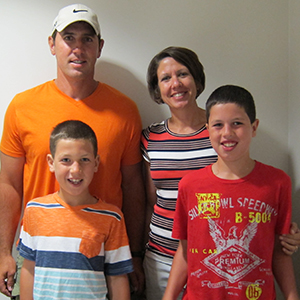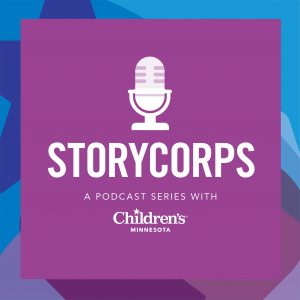Hemophilia: Stephanie, Jim and Nate’s story


About this episode
Mother, father and son discuss their journey in Nate’s hemophilia diagnosis at birth. There was no history of hemophilia in this family. Not only have they embraced his diagnosis but see it as integral to their family. The Millers celebrate the resiliency that often comes with a lifelong, chronic diagnosis. Stephanie highlights the importance of the bond between siblings.
Topics:
- Diagnosed at infancy
- Support: Bleeding episodes
- Resilience: Learning
- Fears and challenges: Limitations
- Advice and messages
Transcript
Nate: I’ve had hemophilia B for a year.
Stephanie: What kind of treatments do you get?
Nate: I get Alprolix. I used to get BeneFix, but then I switched to Alprolix, and I only need to get it once a week. And on BeneFix, I needed to get it like once every two or three days.
Jim: Nate, tell us what you like best about hemophilia, and what do you like least?
Nate: The best, I can go to camp. The worst, I can’t play football, or lacrosse, or jump on a trampoline.
Jim: Did you tell your friends? Do your friends all know that you have hemophilia?
Nate: No. Not all of them.
Stephanie: Do you wear something, though, that some people ask you questions—
Nate: Yeah, I wear my medical alert bracelet on my wrist.
Stephanie: We have no family history of hemophilia – we didn’t know what hemophilia even was. So, Nate was born. Kind of a difficult delivery. He was vacuumed out, so he had a huge hematoma on his head. So like the next day, maybe, that they were doing his heel pokes, and I was feeding him, I was nursing him, and I thought, ‘Oh, he just wet through his diaper,’ because I could feel that my lap was wet, but it was blood.
Jim: The band-aid fell off, or whatever, from the day before.
Stephanie: Yeah. So then that kind of started the whole series of events, really, and testing. So it took them a week. We were at St. Francis- They were looking at bleeding disorders; they were certainly focusing on that. I remember them asking us- are you sure you don’t have an family history. And I remember, after we’d been there for a week, we were starting to think, just on our own, we’ve kind of got to be our own advocate here, and nothing against the hospital at all, but something wasn’t right. So it was right about when we started thinking about, what else should we be doing here? Can we get him transferred somewhere?’ And they did a factor nine test and found that his levels were low. So then we got transferred here to Children’s.
Jim: She rode in the ambulance, and I followed in my car. They sat us down and said, ‘Your son has hemophilia.’ And I remember thinking, okay, he’ll outgrow this, and they’re like, ‘No, he won’t.’ And I feel bad about this, but they kept pushing camp, and it was a little early for camp. [Laughter] ‘He gets to go to camp. He gets to go to camp.’ I’m like, I don’t care. I just wanted to see what a boy with hemophilia looks like. here were so many questions that we had and didn’t know any answers to. And being in the hospital for how many days already?
Stephanie: We’d been there for a week already, yeah.
Jim: It was just a lot going on, and it was just kind of…
Stephanie: just wanted to see like a five year old with hemophilia. You know what I mean? Because you envision the worst.
Jim: And as a disadvantage we have with other families, obviously this is genetic. A lot of these families know, if they’re going to have a kid, they already know something about hemophilia, or have relatives, so they know a little more about it. We were thrown off guard by not having any clue what it was. But we just didn’t know, and now, I’d tell any new family, this is not the end of the world. every kid has something. This is what we’re dealt. There are kids who are scared of water. There are kids who have glasses. There are kids who are in [wheelchairs].’ This is something that we can take care of. It’s knowledge. You learn about it. It’s so doable. Especially with the drugs and the stuff that they have now. I think our first meeting was NHF. And that’s what I loved about going to those things is to meet the families, to see what our next step is. What he’s going to have to deal with at school, what do we do after this, the next few steps. And it was just from one end of the spectrum to the other; it’s just crazy, you know. So we went out there, and I tell Nate about meeting some 60-year-old men who are getting hip replacements and knee replacements because they didn’t have prophy back in the day. And I said, ‘You’re so lucky. They treated as needed, and by then, it was too late. We’re treating before a bleed happens so that you don’t have that.’ So things have changed so much in 20 years, and I’m excited to see in the next 20 years what comes and what we get to look forward to for him. Nate is really active, and I’m not saying he’s the most active sports nut out there, but he’s on travelling teams and stuff, and I know other kids are. But that’s what concerns us, on day six—let’s say he’s got a baseball tournament. We’re still kind of worried.
Jocelyn (pediatric nurse practitioner): That’s a good point.
Jim: And we’re not saying sports is the biggest thing in our lives. We don’t live for sports. It’s not that he has to do this. If he likes it, and it’s given him a lot of self-confidence, belonging on a team and life lessons. Sports teach so many lessons, and that’s so good. And he’s active. It’s keeping him active and not on the couch. There are so many good things from sports, and if he wants to do it, I’m not going to turn him away and say, ‘You can’t do that.’ And that’s why we try to stay positive and say, ‘You know what? Let’s not talk about what you can’t do; let’s talk about what we can do and the sports that we can, and go from there.’ And he has to know too. He’s getting old enough to know, ‘You can go ahead and do that, but there could be consequences.’, I would think is, having hemophilia is making him who he is. He realizes he has a port. And there are kids that’ll say, ‘How come you have three nipples?’ And the port’s coming out. But he has hemophilia, and he’s a little shy to tell people about it, but I think, deep down, that’s teaching him, he doesn’t want to be different, for people to make fun of him. So he’s not going to see a kid in a wheelchair and make fun or a kid. Because he has something, and it’s making him who he is, saying, ‘You know what? I’m not a bully. I’m not going to be a bully.’ Anyway like that. So I think that’s a benefit.
Stephanie: Yeah, I think it’s given him some compassion for others to realize. As much as we say, ‘Oh camp. Who cares about camp?’ when they tell us about camp.
And he loved it. And he came home, and I remember another mom saying to me, ‘Wait till he comes home from camp. Something’s going to be different about him.’ He takes more accountability for all sorts of things. Before you have a kid, you talk about, ‘Here’s how we’re going to parent, and here’s what we’re going to do.’ And I think once he was born, I think we kind of decided, we’re not going to change our parenting, what we had wanted to do, from expectations, from a discipline perspective, because he’s got hemophilia. And so he’s going to follow the rules that Lucas is going to follow. Hemophilia cannot be an excuse for him. It just can’t. Because it’s not an excuse. Instead, we’re kind of trying to teach him, ‘Look at some of these great opportunities you’re getting. And yeah, Nate there are days that are crummy,’ and I think everybody would say that there is. But you think back at how many better days you’ve had; the good far outweigh the bad.
Jim: And that’s the other thing for new parents is, getting involved, but getting in a support group where you can talk to people. That helps so much to know that other families are doing the same thing; they have the same problems, the same questions, the same—and just being with them will help so much, that you’re not by yourself. If we were in our house by ourselves, not knowing anybody with hemophilia, it would be tough.
Stephanie: Yeah, we get a lot of support through HFMD. I’m telling you, the doctors and nurses here, and Jocelyn, yourself—
Jim: You were one of the first ones we met too, and you helped us a lot. Yeah. It’s just the support. And I’m telling you, going to NHF will open your eyes, just to meet with families from other states that don’t have this. I was shocked, just hearing some of these families, where the schools don’t let them do this and that, and we’re so lucky to be where we are in this state, and the doctors. So it’s just a huge—
Stephanie: And that’s another thing I want the boys to know too, is to always be optimistic, and know that they’re fortunate, and they’ve been blessed, and to be thankful for what they’ve got. If you’re listening, boys, be good pals. Always be good pals. Love each other.
We wish to extend our thanks to the families who have shared their story here about the impact of living with hemophilia and sickle cell disease. We would also like to thank the many who worked on this project:
The Children’s Minnesota StoryCorps Legacy Team:
Eddie Gonzalez, Jocelyn Bessette Gorlin, Susan Kearney, Stephen Nelson, Margaret Heisel-Kurth, Stephanie Davis, Angela Blue, Elizabeth McDonough, Jill Swenson and Alisa Linne.
Special thanks to:
Stephanie Moua, Hamdi Hussein, Sadia Farah, Fatima Ali, Caillyn Costello, Suzanne Lehman, Suzan Ulrich, D'Ann Urbaniak Lesch, Justin Nelson, Allison Albright, Marvin Holmes-Leopold, Jose Rodriguez and Mitch Hare.
Minneapolis Institute for Production and Recording:
Jose Rodriguez and Mitch Hare.